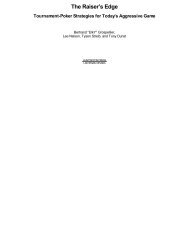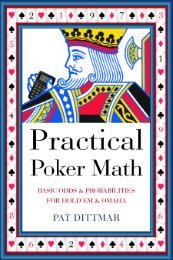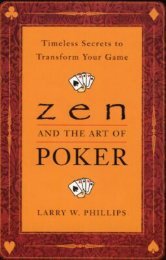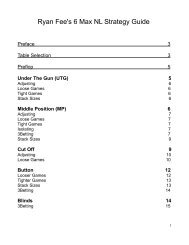Create successful ePaper yourself
Turn your PDF publications into a flip-book with our unique Google optimized e-Paper software.
Given an assumption of averaging 80% equity when getting allin,<br />
our opponent would need to stack with almost 11 times what<br />
we had to call preflop. However, there’s more to the story.<br />
129<br />
When our opponent starts with KK, and we flop a set, an A will<br />
also hit the flop about 16% of the time. We may be very<br />
unlikely to get our opponent’s stack now since he may be afraid<br />
we have an A. Of course, this gets worse when he holds QQ as a<br />
K and/or an A may flop. This cuts down on our implied odds.<br />
You also need to consider how well you play postflop. Will you<br />
have a hard time folding 88 when the flop comes 67s3, and the<br />
villain bets pot? Do you read hands well enough to handle these<br />
situations in a way that maximizes your earnings and/or<br />
minimizes your losses? Also, many times you’ll be out of<br />
position postflop, and it will be difficult to extract money from<br />
much of your opponent’s range.<br />
A good tip here is to set-mine when you know your opponent’s<br />
range is strong. If your opponent is a tight player and raises<br />
from early position, he’s likely to have a very strong hand range.<br />
If your opponent is a loose and aggressive player and raises from<br />
late position, his hand range is likely quite weak. The stronger<br />
hand ranges will find more reasons to get all-in on many more<br />
flops than a weaker hand range.<br />
Some players have recommended set-mining only if your<br />
opponent has started with 25 times the amount you have to call<br />
preflop. While I think this is a bit excessive, I think we’ve seen<br />
the point clearly. We need more implied odds to strictly setmine<br />
than we may think by looking at the odds of flopping a set<br />
or better. If you play well postflop and have a good handle on<br />
your opponent’s strategy, my recommendation would be making<br />
sure your opponent has about 15 times what you must call<br />
preflop. This is just a generalization, and table conditions and









